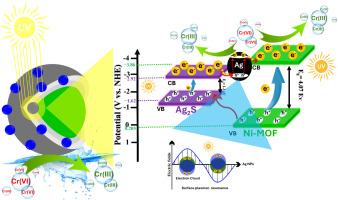Tandem incorporation and encapsulation of Ag2S nanoparticles onto a nickel metal-organic framework decorated with Ag NPs heterojunction for efficient photoreduction of Cr (VI)
IF 5.4
3区 化学
Q1 CHEMISTRY, INORGANIC & NUCLEAR
引用次数: 0
Abstract
Cr(VI) pollution has become a growing concern, posing significant challenges to the chemical industry and environmental protection efforts. Addressing this issue is critical for ensuring ecological and industrial sustainability. In this work, a novel ternary heterojunction nanocomposite Ag/Ag2S@Ni-MOF was successfully engineered and synthesized using a hydrothermal method. The Ag₂S content was optimized, with the best performance achieved at 30% Ag₂S, resulting in a material named Ag/30%Ag₂S@Ni-MOF. This material demonstrated enhanced photocatalytic activity for chromium reduction under UV light irradiation. The Ag/30%Ag₂S@Ni-MOF hybrid photocatalyst effectively reduces 20 mg/L of Cr (VI) in an aqueous solution to nearly 100% within 70 min under UV-light illumination. The photocatalyst exhibits maximum photoreduction efficiency, as indicated by a first-order rate constant of 0.103 × 10−1 min−1. The most favorable Cr (VI) photoreduction performance was recorded at an optimal pH of 2. The remarkable photocatalytic efficiency of Ag/30%Ag₂S@Ni-MOF can be assigned to the synergistic interaction among Ag nanoparticles, Ag₂S, and Ni-MOF, which facilitates the formation of photocatalyst heterojunctions, and thus enhances the migration of photoexcited electrons from Ag₂S to Ni-MOF, successfully minimizes electron-hole recombination and improves the overall photocatalytic performance. Additionally, the surface plasmon resonance effect of Ag/30%Ag₂S@Ni-MOF plays a crucial role in boosting the photoreduction performance of Cr (VI).

Ag2S纳米颗粒串联包封在Ag NPs异质结修饰的镍金属有机骨架上用于Cr (VI)的高效光还原
Cr(VI)污染已成为人们日益关注的问题,对化学工业和环境保护工作提出了重大挑战。解决这个问题对于确保生态和工业的可持续性至关重要。本文采用水热法成功地设计和合成了一种新型三元异质结纳米复合材料Ag/Ag2S@Ni-MOF。优化了Ag₂S的含量,在30%Ag₂S时达到最佳性能,得到了Ag/30%Ag₂S@Ni-MOF材料。该材料在紫外光照射下表现出增强的铬还原光催化活性。Ag/30%Ag₂S@Ni-MOF混合光催化剂在紫外光照射下,在70 min内有效地将水溶液中20 mg/L的Cr (VI)降低到接近100%。该光催化剂表现出最高的光还原效率,一级速率常数为0.103 × 10−1 min−1。Cr (VI)光还原性能最佳的条件是pH为2。Ag/30%Ag₂S@Ni-MOF的显著光催化效率可归因于Ag纳米粒子、Ag₂S和Ni-MOF之间的协同作用,促进了光催化剂异质结的形成,从而促进了光激发电子从Ag₂S向Ni-MOF的迁移,成功地减少了电子-空穴复合,提高了整体光催化性能。Ag/30%Ag₂S@Ni-MOF的表面等离子体共振效应对提高Cr (VI)的光还原性能起着至关重要的作用。
本文章由计算机程序翻译,如有差异,请以英文原文为准。
求助全文
约1分钟内获得全文
求助全文
来源期刊

Inorganic Chemistry Communications
化学-无机化学与核化学
CiteScore
5.50
自引率
7.90%
发文量
1013
审稿时长
53 days
期刊介绍:
Launched in January 1998, Inorganic Chemistry Communications is an international journal dedicated to the rapid publication of short communications in the major areas of inorganic, organometallic and supramolecular chemistry. Topics include synthetic and reaction chemistry, kinetics and mechanisms of reactions, bioinorganic chemistry, photochemistry and the use of metal and organometallic compounds in stoichiometric and catalytic synthesis or organic compounds.
 求助内容:
求助内容: 应助结果提醒方式:
应助结果提醒方式:


